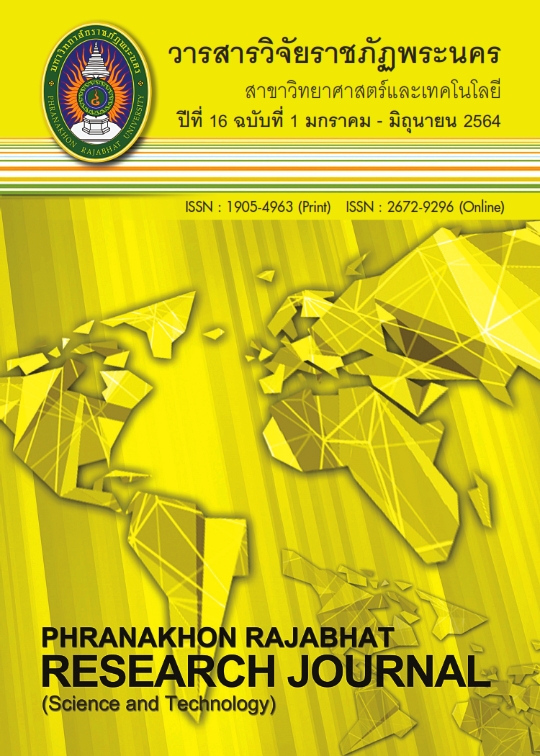DEVELOP FORECASTING PROGRAM FOR CURRICULUM ADMINISTRATION QUALITY IN HIGHER EDUCATION LEVEL WITH MICROSOFT POWER BI.
Keywords:
Analyze Factors in Curriculum Administration Quality, The Structural Equation on Curriculum Administration quality, Forecasting System for Curriculum Administration QualityAbstract
This research aims to develop forecasting system for Curriculum Administration Quality in Higher Education Level with Microsoft Power BI By analyzing factors with affecting the quality of curriculum administration upon the internal quality assessment criteria for the curriculum level of the academic year 2014. Collect data from the self-assessment report by each curriculum at Rajabhat Phranakhon University, 356 data sets from the academic year 2015 to the academic year 2018 and analyze element of the second order confirmatory factor. The results found that the curriculum quality management factors consist of 4 factors first, the teaching and learning process factor which has the 4 indicators as follow 1) the systematic of teaching & learning and teaching process 2) the course content in the curriculum 3) the student evaluation and 4) the process of student enrollment. Second, learner-teacher development factor which has the 2 indicators as follow 1) student promotion and development 2) student capability. Third, the graduate factor which has the 2 indicators as follow
1) percentage of graduates who have been employed or self-employed within 1 year 2) quality
of graduates according to the standard framework National higher education qualifications. Last is
supporting factor which has the 2 indicators 1) Learning support things 2) Teacher management and
development. With the factors weight of 0.998, 0.981, 0.668, and 1.00 respectively will be used in
structural equations to create forecasting models via simple exponential smoothing techniques with
Microsoft Power BI. The results of satisfaction test from 93 users found that the highest satisfaction
level ( = 4.89) and the standard deviation (S.D.) was 0.31.
References
Artaphon, C. & Pallop, P. (2014). Conceptual framework of SCIM-IS for curriculum management based on Thailand Qualifications Framework for Higher Education. International Journal of Managing Value and Supply Chains (IJMVSC), 5(4), 33-45.
Jitthavech, J. & Lorchirachoonkul, V. (2013). Estimators in Simple Random Sampling: Searls Approach.
Songklanakarin Journal of Science and Technology, 35(6), 749-760.
Kline, P. (1994). An easy guide to factor analysis. Routedge, New York.
Ministry of Education. (2015). Guidelines for Administrative Standards of Higher Education Curriculum 2015. Retrieved from http://www.mua.go.th/users/bhes/ front_home/ criterion58/management%20criterion%20_58.PDF. [2018, 7 June.] (in Thai)
Office of the Higher Education Commission: OHEC. (2014). Internal Education Quality Assurance
Guide Highereducation level2014. Bangkok: Office of the Higher Education Commission in Ministry of Education. (in Thai)
Patthama, T. (2018). Business Intelligence Systems To Support Executive Forecasting And Decisions
Making Case Study: Healthcare. Veridian E-Journal, Science and Technology Silpakorn University, 5(4), 16-30. (in Thai)
Saris. W.E. & Strenkhorst. L H. (1984). Causal modeling non experimental research: Dissertation Abstract
International. An Introduction to the lisrel approach, 47(7), 2261-2270.
Srisurin, K., Janngam, S. & Rattana, W. (2016). The factors affecting to internal quality assurance success
in Faculty lever of Ratchathani University. The 3rd National Research Conference and Research Presentation 2016 “Moving towards the 2nd decade: Research integration Use of knowledge Towards sustainability”, 4(1), 836-844. (in Thai)
Tipprasert, S., Angskun, T. & Angskun, J. (2011). An Evaluation of Curriculum Quality using Path Analysis
and Data Envelopment Analysis. SuranareeJournal ofSocialScience,5(1), 61 - 75. (in Thai)
Vanichbuncha, K . (2003). Advance Statistics with SPSS for windows. Chulalongkorn University, Bangkok.
Yamane. (1967). Taro Statistic: An Introductory Analysis. New York: Harper &row.
Downloads
Published
Issue
Section
License
โปรดกรอกเอกสารและลงนาม "หนังสือรับรองให้ตีพิมพ์บทความในวารสารวิจัยมหาวิทยาลัยราชภัฏพระนคร สาขาวิทยาศาสตร์และเทคโนโลยี" ก่อนการตีพิมพ์




